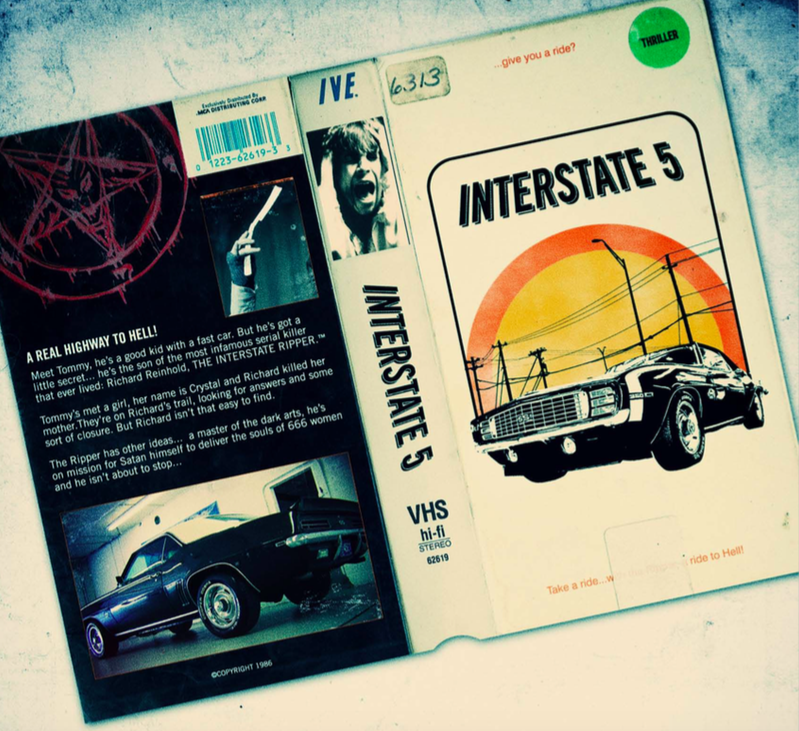Genre: Horror
Premise: The son of an infamous serial killer goes on the road with the daughter of one of the victims to find and stop his father.
About: Today’s spec made The Blood List (the annual list of the scariest screenplays) in 2012 and resulted in the writer, an unknown, getting the job to write the new Texas Chainsaw Massacre film, Leatherface.
Writer: Seth Sherwood
Details: 105 pages
 Interstate 5’s cool title page!
Interstate 5’s cool title page!
It’s Halloweeeeeeeeeeeeen!
Well, it’s almost Halloween anyway.
Actually, it’s still 11 days until Halloween.
But that’s not going to stop us from enjoying the most unnecessary holiday of the year, right? Carson! How could you call Halloween unnecessary?? Well let’s think about this for a second. This is a holiday… ABOUT SCARING PEOPLE. Does that make sense to you?
We’ve got holidays celebrating the birth of Jesus Christ. We’ve got holidays celebrating the birth of a nation. Those holidays feel like there are some actual stakes attached to them, to use a screenwriting phrase. Halloween? It’s like a bunch of dope-smoking teens got together and came up with a joke holiday. “Yo man, they should create a holiday for scaring people.” “Yeah man, and like, you should get candy and shit.”
Hey, I’m not complaining. I still have half my stash of single package Reeses peanut butter cups from 5th grade and I plan to ration those puppies out for another seven years at least. Love me some Resses. But it is one of the stranger curiosities of the American calendar.
Although that’s not the reason I picked Interstate 5 for a Scriptshadow review. It’s important for you guys to know what’s required of a script to get an unknown screenwriter (you) that all-important “big assignment.” Sherwood was just another guy trying to break through the Hollywood gates before he wrote this. Now he’s writing a major horror property. That’s a big deal. Not just for the assignment itself. But once you write on a major property, the rest of the industry takes you seriously. So let’s see what was so special about Interstate 5.
The year is 1985. Noted serial killer Richard Reinhold, who was once captured and thrown in prison, escaped eight years ago, and he’s just started killing again. His victims of choice, like most serial killers, are young women. He picks them up along the highway, rapes them, and carves them like a pumpkin.
But this story isn’t about Richard. It’s about Tommy, a 20-something who was unfortunate enough to be born Richard’s son. Tommy’s life has been a nightmare ever since his father was captured, and now he wants to find some closure. He wants to find his father and kill him.
Tommy is joined by Crystal, whose mother was one of Richard’s victims. The two, armed with Richard’s diary, which details every woman he killed and every place that he stopped at, head down Richard’s famous stomping grounds, Interstate 5, trying to catch up to his killing spree.
Tommy also uses a lot of drugs to cope with his shitty reality. Stress and drugs tend not to mix, so everywhere they stop, Tommy’s convinced he sees the ghosts of the dead victims. Crystal, who was very much pro-Tommy at first, starts to freak out about this, cause she isn’t seeing what he’s seeing.
As they get closer and closer to catching his father, Crystal starts to suspect that Tommy’s losing it. That Tommy may, in fact, be BECOMING his father. The reality, however, is much worse than Crystal could ever imagine. The truth is far far worse.
 More Halloween scripts coming your way!
More Halloween scripts coming your way!
So what makes a good horror movie? Scares? Blood? Scantily clad women running through the forest at night? I’m sure we could have a lively debate about the answer, but I’ll say this. I was watching my favorite show last night, The Walking Dead, a show that has somehow GROWN its audience with every successive season, and I asked myself, “Why do myself and others like this so much?”
The answer came pretty early on. What The Walking Dead does better than any other horror show (or movie), is that it provides a constant impending sense of doom. In last night’s episode, our group runs into a priest. The priest seems feeble, a coward if there ever was one. But the longer the episode goes on, the more suspicious we become of this man. Is he really just a priest? Is he really out here all by himself? What is he hiding? We’re not sure, but we think it’s something. And that makes us worried for our characters, which is why we keep watching. We want to make sure they’re going to be okay.
There are parallels in Interstate 5. I have to admit that the first half of the script was a little bland. They’re basically just looking for his dad. Nothing surprising happens. I’d venture to say there wasn’t a single unexpected moment in the first half (you guys know how this drives me crazy – never give your audience what they expect. Find out what they expect and use that against them).
But then the script does introduce a twist, and it’s a pretty good one (spoilers). It turns out Crystal is working with the police. This whole story she’s concocted about Richard killing her mom is a façade so she can use Tommy to find Richard.
Not only does this introduce dramatic irony (we know Crystal’s a cop, but Tommy doesn’t) but it’s the beginning of Interstate 5’s “impending sense of doom.” Tommy’s starting to lose it. He’s starting to see more of these “ghosts.” He’s starting to feel the memories of his father invade him, change him. We begin to realize that Tommy is not as innocent as he seems. He may have those same genetic psychopathic tendencies, which means that Crystal is in danger. The further they go, the more convinced we become that he’s going to do something to her. Just like The Walking Dead. We stick around to see if she’s going to be okay.
But here’s where things get a little tricky. This “impending sense of doom” device only works IF YOU CARE about the character’s safety. With The Walking Dead, we’ve known those characters for 4 seasons. We’ve developed a connection with them. So of course we’re going to care about their safety.
In Interstate 5, I barely knew Crystal. Beyond her having a dead mom (which didn’t even turn out to be true), I’m not sure I knew one unique thing about her. And this is why feature writing is so hard. You have 1/50th of the space (compared to TV) to create a memorable character the audience cares about. Crystal wasn’t a bad character by any means. But I didn’t LOVE her. And I think the audience has to love a character to care whether they get hurt or not.
Despite that, I think Sherwood did a good job delving into Tommy’s character. Just by being the son of a serial killer and all the baggage that comes with that, you’ve got somebody pretty complex. Add to that a pill addiction, visions, flashbacks to happy times between him and his father, and the demons he’s fighting inside when dealing with Crystal, and this is a pretty strong character exploration.
I think that’s what the producers of Leatherface saw in this. They saw an attempt to explore a character as opposed to another boring jump-scare flick or another boring gore-focused flick. Anybody can write jump scares and gore. Literally, a second grader can write, “And then he stabs her over and over again.” Not that I’d want my kid hanging out with that second grader. But the point is, it’s easy. It takes a lot more skill to explore a character. It shows the producer that you’re willing to look into WHY the character became the way he did. And when you do that, you tend to create more interesting characters.
So why didn’t that happen with Crystal? I’ll get to that in the “What I learned” section. But right now, I’ll just say Interstate 5 is a solid worth-the-read. It was teetering between a “wasn’t for me” and “worth the read” for awhile, but I have to admit, its little twist ending there (a total, “How the heck didn’t I see that coming???” moment) solidified it as a script worthy of your attention.
[ ] what the hell did I just read?
[ ] wasn’t for me
[x] worth the read
[ ] impressive
[ ] genius
What I learned: Remember, when you create “fake” characters, it’s harder to explore them on a real level. One of the reasons I never connected with Crystal was because Crystal’s character was a lie. She wasn’t who she said she was for half the movie. When you’re writing that kind of character, you can’t have the character talk about their REAL life, their REAL experiences, because to do so would give up who they secretly were. So the reader’s only going to get a shell of who the character is. False characters are great for twists, but they provide a challenge on the character development front. So make sure to weigh the risks versus the rewards when you write this kind of character.

